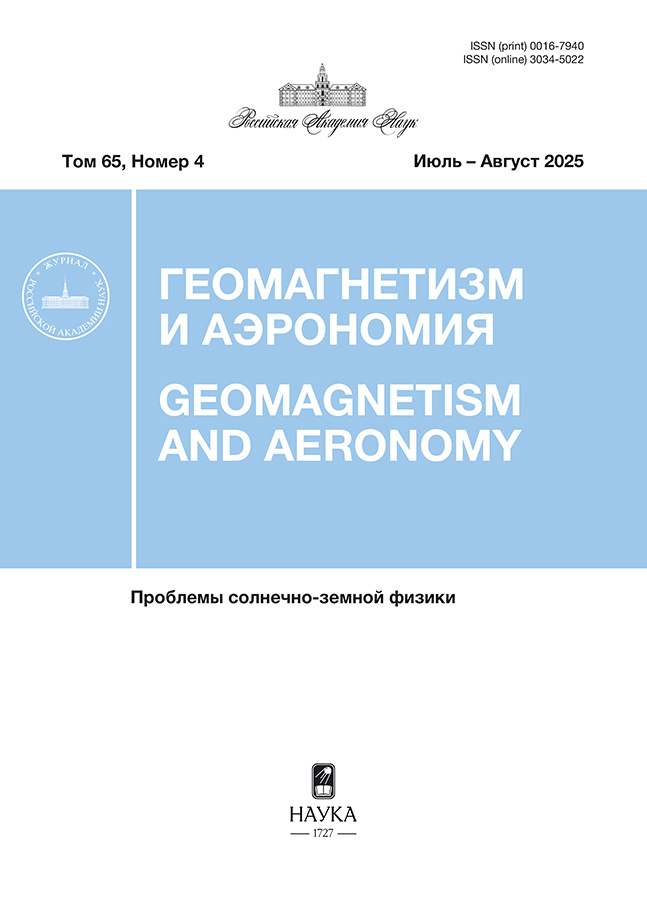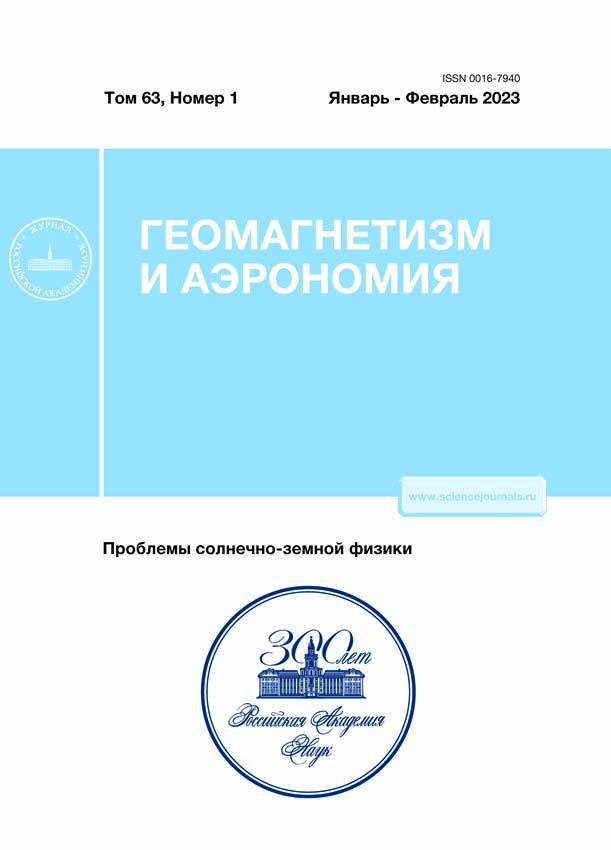Aeronomic and Dynamic Correction of the Global Model GTEC for Disturbed Conditions
- Authors: Shubin V.N.1, Gulyaeva T.L.1, Deminov M.G.1
-
Affiliations:
- Institute of Terrestrial Magnetism, the Ionosphere, and Radio Wave Propagation
- Issue: Vol 63, No 1 (2023)
- Pages: 80-93
- Section: Articles
- URL: https://ruspoj.com/0016-7940/article/view/651041
- DOI: https://doi.org/10.31857/S0016794022600491
- EDN: https://elibrary.ru/ADCXDC
- ID: 651041
Cite item
Abstract
An aeronomic and dynamic correction of the GTEC median global model of the total electron
content for disturbed conditions (Ap ≥ 15 nT) is proposed. The GTEC global median model is developed
for quiet conditions (Ap < 15 nT) as a function of the geographic coordinates, universal time UT, day of the
year, and solar activity level (the solar radio emission flux F10.7). The model is based on a spherical harmonic
analysis of the GIM-TEC Global Ionospheric Maps (1996–2019) provided by the Jet Propulsion
Laboratory (NASA). The proposed GDMTEC global dynamic model (Global Dynamic Model of TEC)
consists of the GTEC median model updated with several dynamic and aeronomic corrections related to
formation of the main ionospheric trough, position of the auroral ionization maximum and changes of the
thermospheric temperature and composition. The advantage of the proposed corrections of the median
model is the independence of forecast of the data in real time from assimilation of the current observational
data. Testing of the model for disturbed conditions shows an improvement of the forecast compared to the
IRI-Plas ionospheric reference model
About the authors
V. N. Shubin
Institute of Terrestrial Magnetism, the Ionosphere, and Radio Wave Propagation
Email: shubin@izmiran.ru
Moscow, Russia
T. L. Gulyaeva
Institute of Terrestrial Magnetism, the Ionosphere, and Radio Wave Propagation
Email: shubin@izmiran.ru
Moscow, Russia
M. G. Deminov
Institute of Terrestrial Magnetism, the Ionosphere, and Radio Wave Propagation
Author for correspondence.
Email: shubin@izmiran.ru
Moscow, Russia
References
- – Аннакулиев С.К., Деминов М.Г., Шубин В.Н. Полуэмпирическая модель бури в ионосфере средних широт // Солнечно-земная физика. Вып. 8. С. 145–146. 2005.
- – Деминов М.Г. Ионосфера Земли: закономерности и механизмы // Электромагнитные и плазменные процессы от недр Солнца до недр Земли. Pед. В.Д. Кузнецов. М.: ИЗМИРАН. С. 295–346. 2015. https://www.izmiran.ru/IZMIRAN75/
- – Деминов М.Г., Шубин В.Н. Эмпирическая модель положения главного ионосферного провала // Геомагнетизм и аэрономия. Т. 58. № 3. С. 366–373. 2018. https://doi.org/10.7868/S0016794018030070
- – Деминов М.Г., Шубин В.Н., Бадин В.И. Модель критической частоты Е-слоя для авроральной области // Геомагнетизм и аэрономия. Т. 61. № 5. С. 610–617. 2021. https://doi.org/10.31857/S0016794021050059
- – Кринберг И.А., Выборов В.И., Кошелев В.В., Попов В.В., Сутырин Н.А. // Адаптивная модель ионосферы. Ред. Л.А. Щепкин. М.: Наука. С. 1–133. 1986.
- – Шубин В.Н., Аннакулиев С.К. Модель отрицательной фазы ионосферной бури на средних широтах // Геомагнетизм и аэрономия. Т. 35. № 3. С. 79–87. 1995.
- – Шубин В.Н., Аннакулиев C.К. Полуэмпирическая модель foF 2 ночной субавроральной ионосферы в период отрицательной фазы интенсивных ионосферных бурь // Геомагнетизм и аэрономия. Т. 37. № 4. С. 26–34. 1997.
- – Шубин В.Н., Деминов М.Г. Глобальная динамическая модель критической частоты F 2 слоя ионосферы // Геомагнетизм и аэрономия. Т. 59. № 4. С. 461–473. 2019. https://doi.org/10.1134/S0016794019040151
- – Alken P., Thébault E., Beggan C. et al. International Reference Geomagnetic Field: the thirteenth generation // Earth Planets Space. V. 73. 2021. https://doi.org/10.1186/s40623-020-01288-x
- – Bilitza D., Altadill D., Truhlik V., Shubin V., Galkin I., Reinisch B., Huang X. International Reference Ionosphere 2016: from ionospheric climate to real-time weather predictions // Space Weather. V. 15. P. 418–429. 2017. https://doi.org/10.1002/2016SW001593
- – Cesaroni C., Spogli L., Aragon-Angel A., Fiocci M., Dear V., De Franceschi G., and Tomano V. Neural network based model for global total electron content forecasting // J. Space Weather Space Clim. V. 10. 11. 2020. https://doi.org/10.1051/swsc/2020013
- – Galkin I., Fron A., Reinisch B. et al. Global monitoring of ionospheric weather by GIRO and GNSS data fusion // Atmosphere. V. 13. 371. 2022. https://doi.org/10.3390/atmos13030371
- – Gulyaeva T. L., Bilitza D. Towards ISO Standard Earth Ionosphere and Plasmasphere Model // New Developments in the Standard Model. Ed. R. J. Larsen. N.Y.: NOVA Sci. Pub. P. 1–39. 2012.
- – Gulyaeva T. L., Arikan F., Hernandez-Pajares M., Stanislawska I. GIM-TEC adaptive ionospheric weather assessment and forecast system // J. Atmos. Solar-Terr. Phys. V. 102. P. 329–340. 2013.
- – Hierl P.M., Dotan I., Seeley J.V., Van Doren J.M., Morris R.A., Viggiano A.A. Rate constants for the reactions of O+ with N2 and O2 as a function of temperature (300–1800 K) // J. Chem. Phys. V. 106. P. 3540–3544. 1997.
- – Iluore K., Lu J. Long short-term memory and gated recurrent neural networks to predict the ionospheric vertical total electron content // Adv. Space Res. V. 70. № 3. P. 652–665. 2022. https://doi.org/10.1016/j.asr.2022.04.066
- – Lean J.L. One- to 10-day forecasts of ionospheric total electron content using a statistical model // Space Weather. V. 17. P. 313–338. 2019. https://doi.org/10.1029/2018SW002077
- – Liu L., Zou S., Yao Y., Wang Z. Forecasting global ionospheric TEC using deep learning approach // Space Weather. V. 18. № 11. 2020. https://doi.org/10.1029/2020SW002501
- – Picone J.M., Hedin A.E., Drob D.P., Aikin A.C. NRLMSISE-00 empirical model of the atmosphere: Statistical comparisons and scientific issues // J. Geophys. Res. V. 107. P. 1468–1483. 2002.
- – Shubin V.N., Gulyaeva T.L. Global mapping of Total Electron Content from GNSS observations for updating IRI-Plas model // Adv. Space Res. V. 69. № 1. P. 168–175. 2022. https://doi.org/10.1016/j.asr.2021.09.032
Supplementary files





















